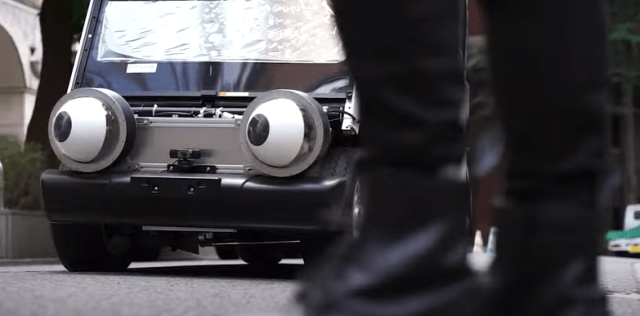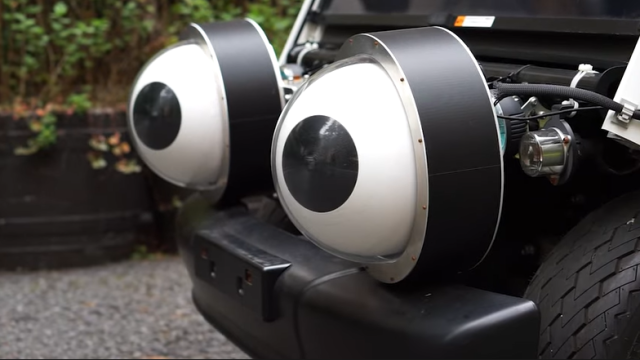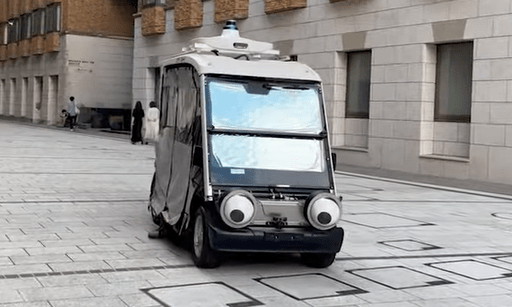University of Tokyo lecturer suggests giving cars big cartoon eyes will make them safer

The cars have eyes.
In urban areas, crosswalks are always a roll of the dice. These zebra-striped paths are intended for pedestrians to cross freely without fear of getting struck by a car, and for the cars themselves to know they should stop upon seeing a person using them.
That’s how it all works in theory, but as anyone who lives in a city will tell you, drivers don’t always heed this rule. Before I never crossed when a car was near because I never really trusted that the driver was alert enough to see me. On the other hand, after getting a license of my own I softened on the issue because now I realize that not crossing the street kind of screws with the driver’s head too.
This failure to communicate is quite a dilemma, and it sure would be nice if there was a visual reference that would let pedestrians know that a driver sees them and validates them as a person that shouldn’t be struck with their heavy machinery.
But maybe there is…
Although it rather looks like it, this video is not a joke. It’s “Gazing Car,” the concept of Chia-ming Chang, a lecturer at the University of Tokyo’s Department of Creative Informatics. Chang uses his extensive background in design to come up with ways to connect people and technology more smoothly.
In this instance, the problem of people being accidentally hit by autonomously driven cars is addressed. On the driver’s side, signals are given when people and objects are detected in the vicinity of the vehicle, but everyone outside the car is blind to these and can only guess if the car can see them.

Chang’s concept gives pedestrians a very clear indication if the car’s sensors can detect them in the form of delightfully big eyes on the front. As plain as day, anyone can know what the car sees, and then make more informed judgments about whether to cross the street or not.
A preliminary study of nine men and nine women using a VR reenactment of crossing the street with both an eyed and eyeless car was held and the results suggest that the eyes did have an effect on the pedestrians’ ability to judge whether it was safe to cross or not.
A video demonstration of the idea was posted on YouTube last month and got mixed reviews from comments such as the following.
“It’s an interesting idea that the human side understands, ‘he ain’t looking at me.'”
“Unique! It’s great to see ideas like this come to life.”
“Anthropomorphism, great stuff!”
“How do we make self-driving cars even creepier?”
“I like this concept of bringing human interaction into autonomous vehicles. While driving we don’t only interact with other vehicles we interact with the actual driver. Usually with hand signals like telling other drivers to go or giving the bird…”
“You’re quoting safety information (reduction in accidents) on a study with nine participants?”
“So this is still something that puts the burden on pedestrians to be safe, rather than on the vehicle or its driver.”
“Hope this is a joke.. LMAO..”
This is all still at the concept stage, and there’s no argument that more research is needed to confirm that cars with moving eyeballs really do increase safety. Also, a future design based on the same principles could end up as something less conspicuous than big cartoon eyes…though I sincerely hope not.
▼ Aw, what’s wrong?

The only question I have is that since autonomous cars can sense multiple objects at the same time, how do the eyeballs react to seeing a pedestrian on each side of the road simultaneously? It would seem the two options are for it to go all wall-eyed or have its eyes dart around all suspicious like — either of which would be a winning idea.
Actually, this would seem even more useful with cars driven by humans. Install a type of facial mapping system to detect the driver’s line of sight and have it be shown in the cars’ eyes. You could even tell if they were looking down at a smartphone or dozing off this way.
Maybe then, we could all use crosswalks the way they were meant to be used.
Source: Gazing Car, Chia-ming Chang
Images: YouTube/AdonisChang
● Want to hear about SoraNews24’s latest articles as soon as they’re published? Follow us on Facebook and Twitter!
Credit:

0 comments:
Post a Comment